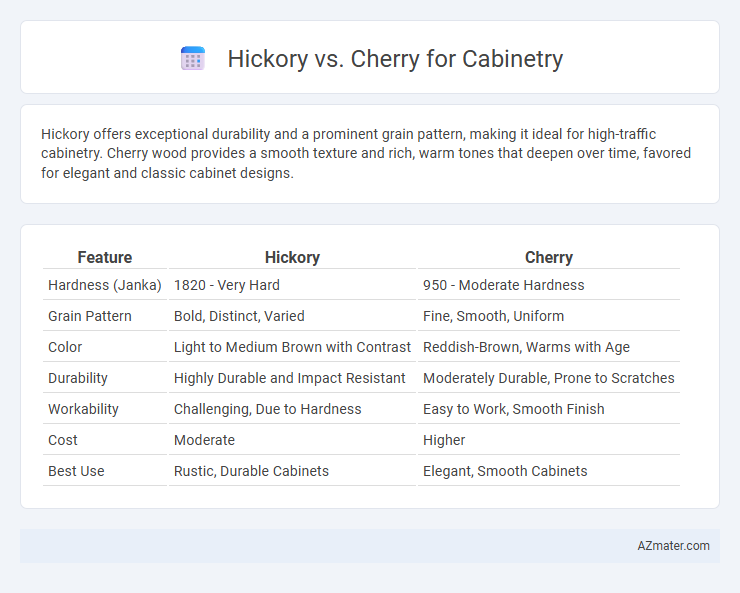Hickory offers exceptional durability and a prominent grain pattern, making it ideal for high-traffic cabinetry. Cherry wood provides a smooth texture and rich, warm tones that deepen over time, favored for elegant and classic cabinet designs.
Table of Comparison
| Feature | Hickory | Cherry |
|---|---|---|
| Hardness (Janka) | 1820 - Very Hard | 950 - Moderate Hardness |
| Grain Pattern | Bold, Distinct, Varied | Fine, Smooth, Uniform |
| Color | Light to Medium Brown with Contrast | Reddish-Brown, Warms with Age |
| Durability | Highly Durable and Impact Resistant | Moderately Durable, Prone to Scratches |
| Workability | Challenging, Due to Hardness | Easy to Work, Smooth Finish |
| Cost | Moderate | Higher |
| Best Use | Rustic, Durable Cabinets | Elegant, Smooth Cabinets |
Introduction to Hickory and Cherry Wood for Cabinetry
Hickory wood offers exceptional strength and a striking grain pattern with rich color variations, making it a popular choice for durable cabinetry. Cherry wood is prized for its smooth texture, warm reddish-brown hues, and ability to darken gracefully over time, adding elegance to any kitchen or bathroom. Both woods provide distinct aesthetic and functional qualities, with hickory emphasizing rustic robustness and cherry highlighting refined sophistication.
Appearance and Color Differences
Hickory cabinetry features a bold, rustic appearance with prominent grain patterns and natural knots, offering a rugged texture that adds character to kitchens. Cherry wood displays a smooth, fine grain with a rich, warm reddish-brown hue that deepens and darkens elegantly over time. The stark contrast between Hickory's variable light to dark tones and Cherry's consistent, deepening color makes each ideal for distinct aesthetic preferences in cabinetry design.
Grain Pattern Comparison
Hickory cabinetry features a pronounced, irregular grain pattern with strong contrasts between light and dark streaks, offering a rustic and bold aesthetic. Cherry wood displays a smooth, fine grain with subtle, uniform patterns that deepen in color over time, providing a warm and elegant appearance. Choosing between hickory and cherry depends on whether a homeowner prefers dramatic, textured grain or refined, consistent grain for their cabinetry design.
Durability and Hardness
Hickory boasts exceptional durability and hardness, ranking around 1,820 on the Janka hardness scale, making it one of the toughest hardwoods suitable for cabinetry. Cherry wood, with a Janka hardness of approximately 950, is softer and more prone to dents and scratches compared to hickory but offers a smoother finish and rich color that deepens over time. For cabinetry requiring heavy use and maximum resistance to wear, hickory outperforms cherry in strength while cherry provides superior aesthetic appeal.
Cost and Affordability
Hickory cabinets generally cost less than cherry, offering a more budget-friendly option for high-quality hardwood cabinetry. Hickory's durability and distinctive grain provide excellent value without compromising aesthetics, making it suitable for affordable kitchen remodels. Cherry wood, known for its rich color and smooth finish, commands a higher price due to its premium appearance and aging characteristics, impacting overall cabinetry cost.
Workability and Installation
Hickory offers superior workability due to its dense grain and hardness, making it more challenging to carve but highly durable for cabinetry. Cherry is easier to machine and install, with a smoother texture that allows for precise cutting and fastening during cabinetry installation. Both woods provide stability, but Cherry's consistent grain pattern simplifies installation, while Hickory requires more careful handling to avoid splintering.
Maintenance and Cleaning
Hickory cabinetry requires regular dusting and occasional polishing to maintain its rugged texture and resist dirt buildup, with moderate sensitivity to moisture emphasizing the need for quick spill clean-up. Cherry wood, known for its smooth grain, benefits from gentle cleaning using a soft cloth and mild soap, as harsh chemicals can damage its rich finish and accelerate aging. Both woods respond well to routine maintenance, but cherry may require more careful treatment to preserve its color and prevent surface scratches.
Best Design Styles for Each Wood
Hickory cabinetry complements rustic, farmhouse, and traditional design styles with its strong grain patterns and natural color variation that add warmth and character to interiors. Cherry wood features a smooth texture and rich, reddish-brown hue, making it ideal for classic, transitional, and formal design styles that emphasize elegance and timeless appeal. Both woods enhance cabinet aesthetics, with hickory offering a bold, earthy look and cherry providing a refined and polished finish.
Environmental Impact and Sustainability
Hickory cabinets are sourced from fast-growing hardwood trees, making them a more sustainable option due to their relatively short harvesting cycle and regenerative growth. Cherry wood, while prized for its rich color and durability, grows slower and requires longer periods to mature, resulting in a higher environmental impact from logging. Choosing hickory supports responsible forestry practices and reduces deforestation risks, aligning better with eco-friendly cabinetry goals.
Which Wood is Right for Your Cabinets?
Hickory offers exceptional durability and a rich grain pattern, making it ideal for high-traffic cabinetry that requires strength and resilience. Cherry wood provides a smooth texture and deepens in color over time, lending elegance and warmth to kitchen cabinets. Your choice between Hickory's rugged character and Cherry's refined appearance depends on balancing functionality with desired aesthetic appeal in your cabinetry.

Infographic: Hickory vs Cherry for Cabinetry
 azmater.com
azmater.com